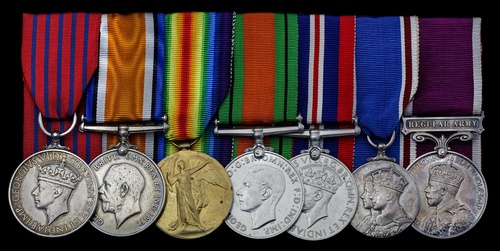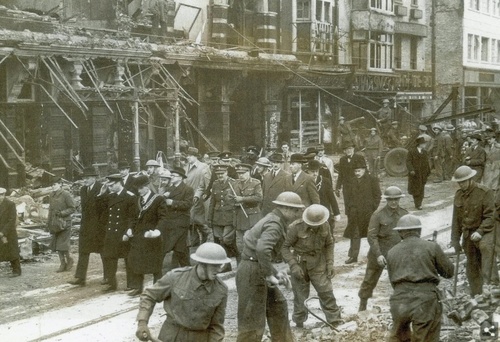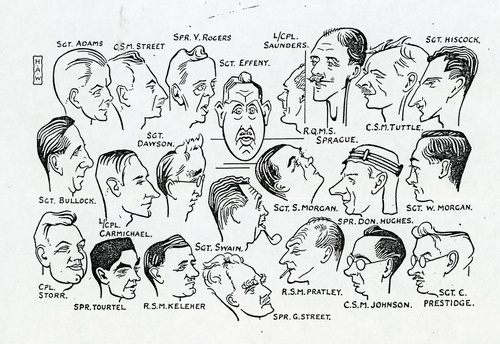Auction: 19003 - Orders, Decorations and Medals
Lot: 378
'The turmoil was indescribable. Endless cascades of incendiaries were interspersed with torrents of high explosive bombs. Even the most savage convulsion of nature could convey no idea of the universal uproar and clamour. Every possible form of terror was present.
Every second or two the town (sic) was shaken to its foundations. The air was a whirling frenzy; hot blasts swept the streets; the town was quickly becoming a sea of flame from which, in regular and horrible sequence, rose cascades of flying debris, red and yellow vapour, a swirling columns of smoke… a terrifying situation developed'
Southampton Blitz, the Unofficial Story, refers
An outstanding 'Southampton Blitz' 1940 G.M. group of seven awarded to Captain J. Keleher, Ordnance Survey Company, Royal Engineers, a veteran of the Western Front and North Russia who was decorated for his leadership of fire-fighting parties on three separate occasions during the most intense aerial bombardments to 'The Gateway to the World'; the glow of the raging firestorms could be seen from as far away as Cherbourg
George Medal, G.VI.R. (Capt. Jack Keleher (106713) R.E.); British War and Victory Medals (341904 Spr. J. Keleher. R.E.); Defence and War Medals 1939-45; Coronation 1937; Army L.S. & G.C., G.V.R., Regular Army (1855342 W.O. Cl.II., J. Keleher. R.E.), minor edge bruise to first, nearly very fine and better (7)
G.M. London Gazette 11 March 1941. The original recommendation states:
'During the air attack on Southampton on 23rd November, 1940, a number of high explosive and incendiary bombs fell in and around the Ordnance Survey Offices. Three incendiaries fell on or among buildings in the enclosure. Captain Keleher was in charge of the inlying picquet, and his prompt action resulted in all the bombs being dealt with before serious damage had been done.
On 30th November, 1940, another more severe attack was made on the town. The attack started with the dropping of flares, incendiary and high explosive bombs, many of which fell in and around the Ordnance Survey Offices, where Captain Keleher was again in charge. Numerous fires were started and Captain Keleher personally led the fire-fighting parties against these. Although high explosive and incendiary bombs continued to fall for several hours - three heavy bombs wrecking buildings, while at least six more high explosive bombs fell within fifty yards of the boundary fence - Captain Keleher continued to direct and lead the fire parties throughout the night.
The following night the attack was renewed, further high explosive and incendiary bombs falling round the offices - one building in which was wrecked and fired by a direct hit. Although he had been up all the previous night, Captain Keleher again led the fire parties in an attempt to save this building. Throughout the attacks he showed great gallantry, initiative, devotion to duty, and fine leadership.'
Jack Keleher was born on 23 July 1899 at Southampton, the son of William and Alice Keleher of 123 Firgrove Road, Freemantle, Southampton. Educated at Taunton School, Keleher attested for the Royal Engineers on 20 September 1916, giving his calling as Ordnance Surveyor Apprentice. He then served as a Sapper with the Army Reserve, being appointed Skilled Surveyor on 8 November 1917 and posted to the 19th (Field Survey) Company at Southampton on 3 April 1918. His skills were much in demand following the stalemate on the Western Front. It was therefore the ability to survey the ground to identify enemy positions which had become more important than ever. In later months, as the war reached its conclusion and the Allied armies pushed towards the Hindenburg Line, Commanders increasingly requested accurate maps of carefully concealed defences, gleaned from the analysis of photographs taken above the battlefields.
From 8 July 1919-9 October 1919, Keleher served with the Royal Engineers in North Russia where he was tasked with surveying the landscape of Murmansk and the Northern Peninsula. He returned home to England and was promoted Lance Corporal on 28 April 1923 and Corporal soon thereafter, having passed the Trade Test (Surveyor) Group 'A', Class I. In August 1925, Keleher departed Tilbury Docks aboard the S.S. Mulbera and spent the next 23 months serving with the Anglo-Italian Jubaland Boundary Commission in East Africa, where he learned Swahili. He returned home on 10 July 1927 and re-engaged on 11 September 1928 to complete 21 years' Army service, being promoted Sergeant on 1 May 1931 and awarded the L.S. & G.C. Medal on 1 April 1936. Permitted to continue beyond 21 years, Keleher was finally discharged for the purpose of being appointed to an emergency commission with the Royal Engineers on 10 November 1939.
Southampton Blitz
During the Second World War, 57 separate attacks were made on the City of Southampton which was within easy reach of Nazi-controlled airfields in northern France. The raids commenced with ineffective, almost casual attacks by small numbers of aircraft aiming at strategic targets, most notably the Supermarine Aircraft Factory at Woolston and the Docks. The attacks quickly grew in intensity as Hitler attempted to destroy Britain's manufacturing capability and break the morale and will of the British people.
The first bomb fell on the night of 19 June 1940 during a strike on the military depot at Marchwood. By mid-September, groups of bombers were concentrating with increased success on the shipyards and aircraft factories at the mouth of the Itchen, and on 6 November 1940 the arts block of the Civic Centre was struck by a direct hit. The 500lb high explosive bomb penetrated to the lower floors of the art gallery, killing 35 people, 14 of them children (Southampton at War: 1939-45, refers). On 23 November the Germans launched their first concentrated and sustained attack which attempted to flatten the heart of the City:
'Three incendiaries fell in the Enclosure, the location of these was accurately reported by the look-outs on Jubilee Block. The inlying picquet - Captain J. Keleher, Lieut. Murrell, 6 Sappers and 7 A.T. Boys, promptly dealt with the bombs, which did negligible damage' (The Official Report titled The Air Attacks on Ordnance Survey, refer).
The enemy repeated the attack a week later, following up showers of incendiary bombs with a rain of high explosives. Emerging from No. 11 Shelter on the South Range, Captain Keleher and Lieutenant G. Kendall directed a picquet of 6 Sappers and 7 A.T. Boys throughout the night, the Official Report noting those whom they led, 'did exceedingly well' and 'showed a complete disregard of danger during a heavy bombardment'. Despite such bravery and fortitude, the A.R.P. control room, telephone exchange, and half of the manuscript store were destroyed.
The next evening at 1800hrs on 1 December 1940, the Luftwaffe could once again be heard over the City:
'The Jubilee Block received a direct hit which set fire to the Painter's shop and Paper Store. The R.E. piquet ensured that all doors were opened and rendered any assistance required to A.F.S.'
Hampered by a limited availability of water with which to fight the fire, the A.F.S. were unable to stem the flames and the building was lost. Remaining on duty and leading his party of 20 men throughout the night, Keleher's continuous gallantry and devotion to duty was recognised with the award of the George Medal.
Southampton was repeatedly targeted over the following months and years, the last significant raid being staged in June 1942. An estimated 475 tons of high explosive landed in total on the City, plus nearly 31,000 incendiary devices which destroyed and damaged over 40,000 homes. Approximately 630 people died during the Blitz with 898 seriously hurt and a further 979 slightly injured. Such losses led to a steady stream of people 'trekking' to the safety of the New Forest when the evening came.
In summing up the exodus and loss of spirit, the Hodsoll Report - compiled by Sir John Hodsoll, Inspector General of Civil Defence and declassified in the 1970's - was particularly scathing of the local authorities, especially the Mayor and Town Clerk whom he described as 'incompetent'. Despite visits by the Prime Minister and King George VI, investigators of public morale found that:
'…the excitement, elation and courage with which the townspeople had reacted to the actual bombing had been replaced by an obsession with air raids that was dangerously near a neurosis. Whereas Bristol was carrying on, Southampton seemed dead' (The Hodsoll Report, refers).
As a result, the human problems often fell to local personalities, including Keleher. Remaining at his post throughout the critical period, Keleher was eventually transferred on 14 October 1942 to Barton-on-Sea, Hampshire, as Officer Commanding, A.T. Boy's Wing, Ordnance Survey, being released from service on 2 November 1945; sold with copied service record, extensive research and paperback copies of Southampton Blitz, the Unofficial Story (Published by the Oral History Team, Southampton Local Studies' Section), and The Southampton Blitz (Anthony Brode).
Subject to 20% VAT on Buyer’s Premium. For more information please view Terms and Conditions for Buyers.
Sold for
£5,800
Starting price
£4000









